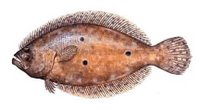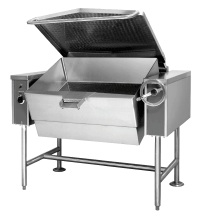
Boy, does it ever make you feel old when you start humming and singing that little ditty, and no one in your class has ever heard of it? (Go here: voobaha.com, and click on the fish head about halfway down the page. Ahhh, memories of Sunday night Dr. Demento shows!)
Monday was all about fish...fish fabrication that is. We discussed the differences between flat fish and round fish...which were basically what I had previously thought. Flat fish are flat (duh!) and are characterized by having both eyes on the top of their bodies, like flounder and Dover sole. They have a dark side (the side that faces up) and a light side--who knew fish were Jedi?
You can usually get 4 quartered fillets from a flat fish--two on the topside and two from the bottom side. Here's a flounder (on the right) and a Dover sole. Dover sole are reportedly better than flounder, and are only found around Dover, England. Having said that, if you Google "Dover sole," you will get tons of links on Pacific sole, etc. I'm guess that unless you actually catch the damn thing your ownself, the average consumer has no idea if the fish speaks with a British accent or Valley Speak ("Oh My God! Gag me with a pin bone!").


It's very important when dealing with these fish, and all fish, is making sure you get all the usable meat off the bones. That's the money maker, and it does you no good to throw half of it in the stock (making) pot. As a whole, our class thought that fabricating fish was much more fun and easier than fabricating chicken. (Although, I did like deboning the chicken thigh/leg a whole lot...weird, I know.)
We also worked on round fish fabrication in the form of pompano.
 You get 2 fillets from round fish, one on either side of the body. The hard part about fabricating the pompano was not getting finned. The back fin can stick you pretty badly if you aren't careful. Pompano are pretty tasty little buggers, too. One of my favorite ways to have them is a Thai-style dish where the fish is fried whole and a spicy sauce with peppers and onions is piled on top. Yum!
You get 2 fillets from round fish, one on either side of the body. The hard part about fabricating the pompano was not getting finned. The back fin can stick you pretty badly if you aren't careful. Pompano are pretty tasty little buggers, too. One of my favorite ways to have them is a Thai-style dish where the fish is fried whole and a spicy sauce with peppers and onions is piled on top. Yum!The third type of fish is the non-bony group, which includes shark, monkfish, and rays. These fish have cartilage instead of bone, hence the non-bony moniker. I do like monkfish, and while I don't think it tastes exactly like lobster ("poor man's lobster" is it's nickname), it does have a sweeter taste and firm flesh like a lobster. A monkfish is one ugly fish. I had never actually seen a whole one until sometime last year when watching a late night episode of Emeril Live. He was doing a fish show and had a monkfish on the counter. Scary! I was hoping not to have nightmares about being chased by a giant monkfish. I'm seeing it now--the next great seafaring horror flick could entail being chased by an "irradiated to the size of Godzilla" monkfish. Check this out:
 Think about one of these puppies all genetically modified to the size of a small battleship coming after you and your little sailboat, too. Eeeeeee!!!
Think about one of these puppies all genetically modified to the size of a small battleship coming after you and your little sailboat, too. Eeeeeee!!!We also discussed the quality indicators of fish--the smell (slightly briny, never fishy!), the skin needs to be intact and scales attached (if you didn't buy scaled fish), the eyes need to be clear, the gills need to be bright or dark red--no brown!, and the flesh should spring back when you press it. Fish is usually the most expensive thing you have on board your menu. It represents a whole lotta moola sitting in your cooler, so you make sure that it is stored properly and used quickly. It's best to store it on ice, in a perforated pan, with a drip pan underneath. Never let fish sit in water, even though that's where they originally lived, because it will cause the flesh to break down more quickly.
We talked about gutting fish, i.e., removing the viscera or entrails. It's important to remove the guts as soon as possible, because they are a major source of deterioration. These terms are used when ordering fish from suppliers: drawn (entrails and guts removed); pan dressed (a fish or portion of fish that is cleaned and can fit in a pan), fillet, and steak.
After we cut up our flounders and pompano, we took the fish carcasses and rinsed them and cut off their fishy little heads. We fired up the tilt skillet and threw them all in to make fish stock. The tilt skillet is a fine and wonderful piece of kitchen equipment for cooking large quantities. It's a big square pot thing on a stand, and has a wheel handle that you turn to tilt the skillet down to pour out the contents. Ours is a 30- or 40-gallon model, and looks kinda like this:
 You can make stock, soup, fry up tons of hamburger meat, braise a bunch of chicken thighs, etc. Ours has a faucet attached, so you can run water right into the skillet and not have to lug it from the sink. And, there is a strategically placed floor drain underneath where the spout would tilt down to use for easy cleanup. One of the more fascinating things about culinary school is seeing some of the industrial equipment used in restaurants, and getting to use it ourselves. Some of it can be rather daunting at first, and it's all hideously expensive. That tilt skillet will set you back $9-$10,000...not something I want coming out of my paycheck if it breaks!
You can make stock, soup, fry up tons of hamburger meat, braise a bunch of chicken thighs, etc. Ours has a faucet attached, so you can run water right into the skillet and not have to lug it from the sink. And, there is a strategically placed floor drain underneath where the spout would tilt down to use for easy cleanup. One of the more fascinating things about culinary school is seeing some of the industrial equipment used in restaurants, and getting to use it ourselves. Some of it can be rather daunting at first, and it's all hideously expensive. That tilt skillet will set you back $9-$10,000...not something I want coming out of my paycheck if it breaks!The stock making also illustrates how the culinary program is run...the things you do in one class will be passed on to others or will be re-used in a later class for you. We'll use the fish fillets during one of our menu class; the stock is sort of a common item that would be used by all classes as needed, etc. I did wonder during the Principles class where all the stuff we used came from...it was sort of like having a magic refrigerator. Chef would say get veal stock out, and we'd go to the common cooler and voila! veal stock would be there. Sometimes we did have to thaw it out from the walk-in freezer, but all the chefs try to keep the common cooler par stocked with certain ingredients. We've also got several other refrigerators and freezers scattered about the kitchen that are used by individual classes. So, when we make a sauce and need to save it for a later class, we put it in our cooler rather than the walk-in or common cooler, so it is "saved" for our use.
Tomorrow, we are going over crustaceans and mollusks...unfortunately, we aren't going to be fabricating or cooking any lobsters, dammit! That would be a lovely afternoon, wouldn't it? Our very own Lobsterfest...I was so hoping for that. We're also going to start fabricating cuts of beef and pork, and Chef Regional is trying to arrange a field trip to a meat wholesaler for us. I'm excited about cutting meat, because I think it will be less icky than chicken or fish, and because I want to learn more about the different cuts and what dishes they would be best for the particular cuts of meat. Sometimes, the array of roasts is rather daunting, because I'm not sure which ones stand up best to long cooking times, etc. The pork products are more of a mystery to me than the beef, so I'm all for more piggy insight. Now, a pig the size of Godzilla would be something...think of the bacon! Mmmm....bacon!

2 comments:
Funny, we always use halibut to make "poor man's lobster" up here. One part sugar to four parts water, boil it until it floats, and then dip it in clarified butter. YUM!
I love the idea of a magic refrigerator - I need one of those!
Your blog always makes me hungry - I need to go cook dinner. Not fish, though. :)
Yup, like Erin, "poor man's lobster" to me means halibut. Boiled in sugar-water, loaded with butter. And that monkfish...ugh. The only time I ever saw one was the episode of "Malcolm In The Middle" in which Reese cooked the Thanksgiving turkey *inside* a whole monkfish, to give it more flavor. Blecccccch.
Post a Comment